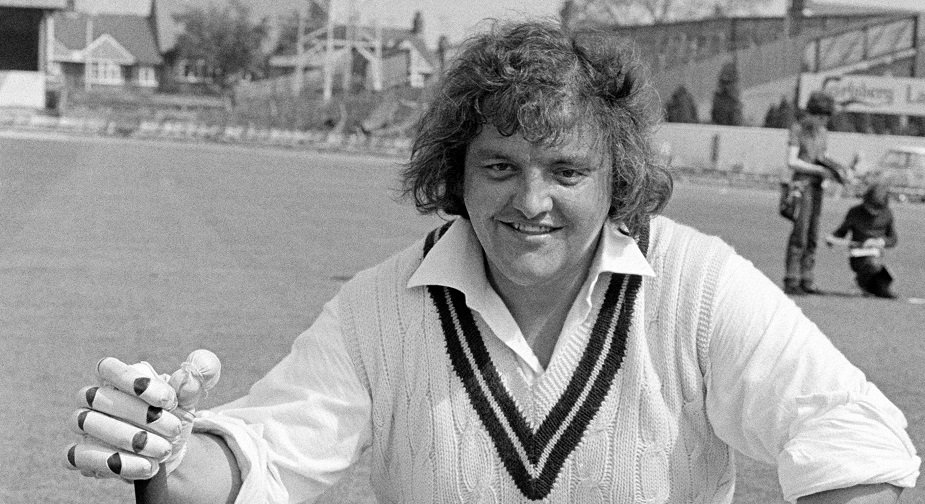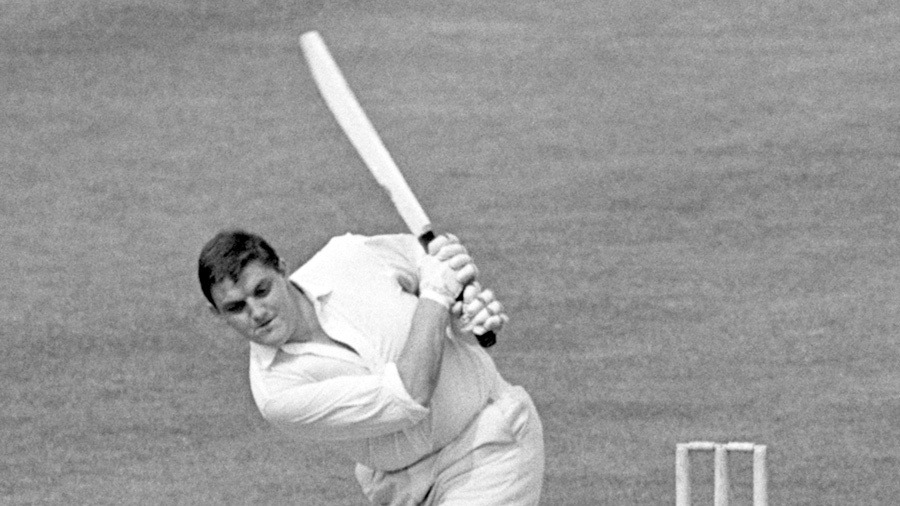Hailing from a North-East coal mining upbringing, Colin ‘Ollie’ Milburn became Northhamptonshire and England cricket’s exuberant heavyweight attraction through the 1960s until a tragic car accident. His swashbuckling style and larger-than-life persona on and off the field enthralled fans and peers alike.
Though his international career comprised a mere nine Tests, Milburn’s club feats like scoring the fastest-ever double century in just 140 minutes against Western Australia left an indelible memory at Northants and beyond.
Article Highlights
Hide- Colin Milburn was born in Burnopfield, County Durham, England in 1941 and showed a passion for cricket from a young age.
- He had a robust physique and keen eye, making him a formidable presence on the pitch.
- Milburn advanced through the ranks of cricket, transitioning from amateur to professional and gaining a reputation as a cricketer of exceptional promise.
- He had numerous career highlights, including record-breaking innings, impressive statistics, and pivotal contributions in the Ashes series, showcasing his skill, ability to perform under pressure, and significance in cricket.
Had a collision with his Jaguar in 1969 not cost him vision in one eye prematurely ending his career, Milburn might have added a towering England record to his over 37,000 first-class runs.
Nevertheless in his short playing span, the loveable, risk-taking Milburn punctured cricket’s cozy world like a meteor flashing brightly but briefly across England’s cricketing landscape – a shooting star who lived life at breakneck speed on the field but also away from it behind the wheel.
Early Life and Background
Growing up in a modest household in Burnopfield, County Durham, England, Colin Milburn demonstrated an early passion for cricket that would lay the foundation for his future success in the sport.
From his earliest days wielding a bat, Milburn’s natural ability was evident. His robust physique and a keen eye made him a formidable presence on the pitch, even in his youth.
This formative period was marked by a voracious appetite for the game, with Milburn spending countless hours honing his skills and understanding of cricket’s nuances.
Peter May
An exemplar of England’s acclaimed amateur batting heritage, Peter May earned his reputation as ... Read More
The environment of Burnopfield, with its working-class roots and a strong sense of community, undoubtedly played a role in shaping Milburn’s character and approach to cricket.
The values of hard work, perseverance, and the pursuit of excellence were ingrained in him from a young age. These principles became the bedrock upon which he built his cricketing philosophy, merging a respect for the sport’s traditions with a relentless drive to push boundaries.
Milburn’s ascent in cricket was not merely a product of talent; it was a testament to his dedication and the deeply rooted love for the game fostered during those early years in County Durham.
His background, far from being a hindrance, served as a powerful motivator, driving him towards the upper echelons of cricketing acclaim.
Rise Through the Ranks
Building upon the strong foundation laid during his formative years, Colin Milburn’s cricket career gained momentum as he advanced through the amateur ranks, showcasing a prowess that caught the attention of professional scouts.
His trajectory through the echelons of cricket was not merely a testament to his talent but also a reflection of his relentless dedication and an indomitable spirit that resonated with the ethos of freedom-seeking enthusiasts.
Milburn’s technique, characterized by an aggressive batting style, was underpinned by a judicious blend of orthodox play and innovative stroke-making.
This approach not only endeared him to fans but also demonstrated a strategic acumen well beyond his years. His ascendancy was marked by a series of robust performances, notably in the Minor Counties Championship, where he emerged as a prodigious talent, compelling the selectors to take note.
His statistical output during this period was not just impressive—it was a harbinger of the impact he was poised to make at the professional level.
Milburn’s ability to dominate bowling attacks, coupled with his appetite for run accumulation, laid the groundwork for an imminent transition to first-class cricket.
It was this period of ascension that ultimately cemented his reputation as a cricketer of exceptional promise, one whose potential was matched only by his ambition to excel at the highest tiers of the game.
Career Highlights and Records
Colin Milburn’s ascent to cricketing stardom was punctuated by a series of remarkable achievements, including record-breaking innings and match-winning performances that etched his name into the annals of the sport.
Milburn’s career highlights reflect not just his personal triumphs, but also his contribution to the game’s history. His aggressive batting style and ability to dominate bowling attacks made him a spectacle that captivated audiences and left an indelible mark on the field.
Analyzing Milburn’s career, one can identify critical performances that defined his legacy. His record-breaking 243 not out for the Marylebone Cricket Club (MCC) in 1966 against the West Indies stands out as a testament to his extraordinary talent.
This innings was emblematic of his fearless approach and his penchant for rapid scoring, which often shifted the momentum of a match.
Below is a table summarizing some of Milburn’s career highlights and records:
| Achievement | Details |
|---|---|
| Highest Individual Score | 243 Not Out against West Indies, 1966 |
| Fastest First-Class Century | Scored in 65 minutes for Northamptonshire, 1965 |
| Test Match Impact | Averaged over 46 in Test cricket with two centuries |
These records not only showcase Milburn’s skill but also his ability to perform under pressure and his significance in the history of cricket.
Notable Innings and Performances
Reflecting on Colin Milburn’s illustrious achievements, it becomes evident that his most notable innings and performances were characterized by an unparalleled blend of power and finesse, often turning the tide of matches in his team’s favor.
His aggressive batting style not only demoralized the opposition but also captivated spectators, igniting a sense of freedom and possibility.
Noteworthy Performances:
- 1966: His monumental 203 against the West Indies at Lord’s demonstrated his dominion over the cricket ball, leaving a lasting imprint on the annals of the game.
- The Ashes: Milburn’s contributions in the Ashes series were pivotal, with innings that often served as the backbone of England’s batting lineup.
Through meticulous analysis, one can discern that Milburn’s performances were not merely acts of athletic prowess; they were manifestations of his indomitable spirit.
Each stroke he played resonated with a message of defiance against the shackles of conventional play, endearing him to those who cherish the essence of freedom in sport.
Emotional Highlights:
- The aura of anticipation among fans as Milburn approached the crease, a prelude to the inevitable spectacle.
- Moments of awe as his willow wielded thunderous blows, symbolizing an athlete’s relentless pursuit of excellence.
Milburn’s legacy is etched in the collective memory of cricket aficionados, serving as an enduring symbol of liberation in the face of conformity.
Legacy and Impact on Cricket
The indelible mark that Colin Milburn left on cricket transcends mere statistics, embodying an ethos of audacity and innovation that forever altered the sport’s narrative.
His approach to batting was emblematic of a fearless spirit, one that sought to challenge and redefine the orthodoxies of cricketing technique and strategy.
Milburn’s aggressive style brought a new dynamism to the game, inspiring a generation to think differently about the art of run-scoring.
Analyzing Milburn’s legacy, one perceives the ripple effect of his flamboyant stroke play and larger-than-life persona. He was not merely a cricketer; he was a harbinger of modern cricket’s entertainment ethos, where assertiveness and rapid run accumulation are prized. Milburn’s influence is palpable in the way contemporary cricketers prioritize scoring rates and innovate with unconventional shots.
Moreover, Milburn’s career serves as a poignant reminder of the vicissitudes of sporting life. His unexpected exit from the game, due to a tragic accident, underscores the ephemeral nature of athletic prowess and the importance of seizing every moment on the field.
As such, Colin Milburn’s impact is etched not only in the record books but also in the philosophical underpinnings of cricket’s evolution.
Final Take
Colin Milburn’s cricketing legacy endures through a career marked by exceptional performances and an unorthodox playing style that captivated audiences.
Despite a career cut tragically short, his impressive statistics and memorable innings attest to a talent that could have scaled greater heights.
Milburn’s impact on the sport transcends numbers, challenging conventional techniques and inspiring a generation to embrace individuality within the framework of team sports. His story remains a poignant reminder of cricket’s unpredictable nature.

















